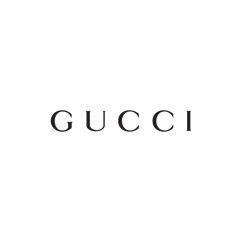
Gucci
In 1891, Guccio Gucci was born into a middle-class family and a long line of leather workers in Florence, Italy. The family fell on hard times shortly after Guccio’s birth, prompting Guccio to leave Italy in search of work. In 1897, Guccio found a job at London’s Savoy Hotel as an elevator operator. Given his heritage, he always kept an eye on the hotel guests luggage. What is now considered a seminal moment in brand history, Guccio’s time at the hotel is when the seeds of the brand Gucci were planted. At the same time, polo and horse racing were increasingly popular, which convinced Guccio that incorporating the culture into his brand was necessary.
In 1921, Guccio went back to Florence and opened House of Gucci as a small, family owned equestrian goods and luggage store. Despite the war taking a devastating toll on the economy in the 1930s, Gucci grew. Guccio’s oldest son, Aldo, joined the business in 1933 and immediately addressed what was in his mind a top priority: the logo. For 12 years, Gucci was operating without a logo, simply using the Gucci family’s coat of arms in its place. Inspired by his father’s name, Aldo designed what would become one of the most recognizable logos in the world: the interlocking Gs.
Guccio passed away in 1953 but his company continued its rise with Aldo and his brother Rodolfo leading the way. While Guccio founded the label, many argue that Aldo is the reason Gucci remains one of the biggest luxury brands in the world. In 1953, Aldo created one of Gucci’s most iconic items: the Horsebit Loafer. The Horsebit Loafer is the item one would use to explain Gucci’s entire thesis, a luxurious leather shoe crafted in an atelier with a metallic ornament inspired by a horse’s mouthpiece. It’s a piece so ingrained in Gucci’s history it remains part of Gucci’s collections to this day.
Gucci enjoyed success through the ’50s, ’60s and ’70s as the booming economy fueled it to open more stores in the United States and Europe. The brand became a status symbol as celebrities like Jackie Kennedy and Sammy Davis Jr. began to be seen with its goods.
The business was changed forever when Rodolfo died in 1983, leaving his son Maurizio Gucci, who joined the business in the early-’70s, to run the company along with Aldo. However, once Rodolfo passed, Maurizio fired Aldo, setting off a chain of events that spelled disaster for Gucci. Maurizio was simply in over his head and in 1988, he sold a controlling stake in the company to Investcorp. In 1993, Maurizio was liquidated of his shares, leaving the Gucci family completely cut out from the company it built.
Investcorp was eager to see a return on its investment and to ensure it did, Bergdorf Goodman president Dawn Mello was hired as “editor” and designer. Mello then appointed the man who oversaw Bergdorf’s accessories Richard Lambertson to be Gucci’s design director. The two then made its most pivotal move by hiring Tom Ford as creative director in 1994.
Ford was inexperienced but Gucci was in a tough position and simply took who it could get. Ford’s debut collection received a lukewarm reaction but it was the ’70s-inspired Fall/Winter 1995 collection that would make him a star and save Gucci simultaneously. Now considered one of the best runway collections of all-time, the collection was highly influential for luxury menswear in ’90s and early ’00s fashion. From Fall/Winter 1995 to Spring/Summer 1997, Gucci’s revenue doubled.
The Tom Ford era brought a new type of glamor to the brand, but in 2004, after 20 years of success, Tom Ford left Gucci. Depending on who you ask, Ford or Gucci’s parent company PPR (now known as Kering), Ford’s departure was about either money or control. Nevertheless, the man who brought sex appeal to Gucci was gone and he left only very large loafers to fill.
Ford was replaced by Frida Giannini, who previously worked at Fendi and then under Ford until his departure. Gucci’s identity under Giannini was wavering, changing from season to season. The brand essentially idled for 10 years when, suddenly, Giannini left Gucci just weeks before the brand’s Fall/Winter 2015 runway show at Milan Fashion Week. In her place, Gucci accessories designer Alessandro Michele was asked to put together a collection. As a student of Ford, Michele too saw the 1970s as a key source of inspiration for Gucci and in just five days, produced a universally loved collection that turned the brand around, just as his mentor did 20 years prior.
Nearly 100 years since it was founded, Gucci is still around and every bit as luxurious as it was then. The brand once known simply for leather goods is now known for a wide variety of goods, including bags, snake embroidered jeans, sneakers slides, T-shirts, and more.
What is Gucci’s cheapest item?
As is true for most luxury brands, Gucci’s most affordable items are its scents, particularly the eau de toilette.
How much is a Gucci bag?
Gucci’s current selection of handbags retail for between $670 and $34,000.
What is Gucci famous for?
While the brand offers a variety of items, the brand is most famous for its leather shoes, handbags and belts.

